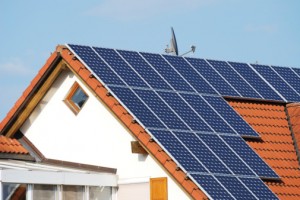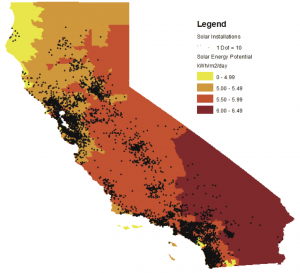Why California's Push for Rooftop Solar is a Foggy Idea

(iStockphoto)
Would you trust your neighbors with billions of dollars of public money to invest in a clean energy future? If you live in California, this isn’t a hypothetical question.
California Gov. Jerry Brown last month announced his intention to rely on “tens of thousands of little decisions” by Californians to develop a 12 giga-watt renewable energy infrastructure by 2020. In remarks at a UCLA clean energy conference, Brown embraced distributed solar generation in order to avoid the pitfalls that often encumber large-scale renewable energy projects, including the capital costs of transmitting energy from far-flung deserts and hilltops. Furthermore, rooftop solar panels and Cameron-esque windmills also pose little threat to desert tortoises or sacred Native American sites, so they are less apt to be caught up in the kind of litigation that has delayed major renewable projects.
But energy policy that relies on distributed generation has its drawbacks. Perhaps most notably, it forsakes economies of scale. It also places infrastructure investment decisions in the hands of homeowners, who, as this space has suggested, may not make socially optimal—or even individually rational—choices.
Early evidence from California suggests that because of these drawbacks, relying on tiny decisions is no silver bullet to a green energy future—and it could be a big mistake.

Many of California's rooftop solar panels are clustered in areas that receive less sunlight than other areas of the state.
How else to describe the state’s decision to partner with homeowners to install 1,923 residential rooftop solar installations in San Francisco, which the National Oceanic and Atmospheric Administration characterizes as having persistent clouds and fog during the summer? Despite the weather, San Francisco is still among the top ten cities in California with the most distributed solar panels per household. Solar panels in San Francisco may generate enough energy over their 20-25-year life spans to repay homeowners for their investments. But it’s clear those green energy dollars could be put to far better use in desert communities, like Apple Valley, where 22% more solar energy lands each year (according to the National Renewable Energy Laboratory), and yet only one in 90 homes harvest it.
If San Francisco’s residential solar panels were relocated to Apple Valley, they would produce another 2.1 million kilowatt-hours (kWh) of electricity each year—enough to power 320 average California homes. That would add as much green energy to the state’s electrical grid as installing another 415 average solar systems in San Francisco. At a $0.12 rate for electricity and a $0.03 environmental value for avoided carbon-based generation, the typical San Francisco solar homeowner could afford to pay an Apple Valley homeowner $167 per year to rent his rooftop and be no worse off.
If less efficient residential solar panels throughout California were moved to the sunniest cities in the state, the entire stock of residential solar would generate 15% more green energy. An optimized rooftop solar program would generate an additional $12.5 million in benefits per year and could power an additional 13,000 homes. The optimization would generate as much additional green energy as adding 7,800 more average residential solar installations to the state’s homes.
In a world where energy conservation programs are heralded as successes if they yield 1-2% demand reductions, a 15% efficiency improvement would be huge. Imagine if the build-out required to meet Gov. Brown’s planned 12 gigawatts by 2020 continues apace. A 15% increase in energy production on 12 gigawatts of installed capacity fuels a half-million homes.
If solar investment decisions were the product of a rational cost-benefit analysis, then solar should be far more prevalent in inland communities that lack the coastal fog and marine layer. After all, if it is individually rational for a San Francisco homeowner to install solar, then it must also be individually rational for just about every other homeowner to follow suit. And yet they don’t.
The solar boom along the fog-laden California coast may be spurred by environmental preferences and even conspicuous conservation effects that yield additional, non-pecuniary dividends to homeowners in coastal green communities. But solar is also well-represented in places you would expect (and hope) to find it. San Diego, for instance, has 2,238 residential solar installations, the most in the state. And Central Valley communities with more sun and more conservative political views, like Fresno, Clovis, and Bakersfield, also rank among the state’s top-ten solar cities.
It is perhaps reassuring that political party affiliation is a poor predictor of solar panel density in California. But it can be of little consolation that NREL’s solar energy potential is only a weakly-significant predictor of solar density, even after controlling for housing stock characteristics, population and housing growth, and household income.
Free-market economists embrace the power of many individual decisions to guide markets and direct resources to their highest value. Yet the burgeoning field of behavioral economics has documented many instances in which consumers make mistakes. Consumer errors are much more likely with large investment decisions that require complex calculations involving discounting and expectations of future prices. Even if consumers execute the discounted cost-benefit calculus correctly, their objectives may be different from those of society, causing efficiency losses for policies that rely on their utility maximizing behavior.
So if homeowners can’t be trusted to make social welfare maximizing investments, and if industrial scale solar projects can’t clear legal hurdles, what should be done?
One option would be to permit the solar swapping that Dubner proposed. But this only works if a homeowner in the desert who won’t invest his own money in a solar array would be willing to rent his roof for less than $200 on average. He may not find that inducement sufficient to overcome transaction costs, not to mention the potential nuisance of housing someone else’s green investment.
A better solution may be for the state to coordinate investment by individual residents in larger, community-based solar installations that could be situated in the sunniest cities—perhaps on rooftops of public or commercial buildings or above parking lots in inland Southern California. Homeowners would receive payments for the energy produced from their share of the projects, much as they do from the projects on their own roofs. Only the payments would be bigger because of their better location. These larger projects would lower transactions costs and capitalize on scale economies, which a consultancy for the state’s energy commission reported to be critical to generating positive net benefits for society. And, as Dubner suggests, the residential investors could get big signs to put on their roofs to replace the “green” signal their solar panels would have sent.

Comments